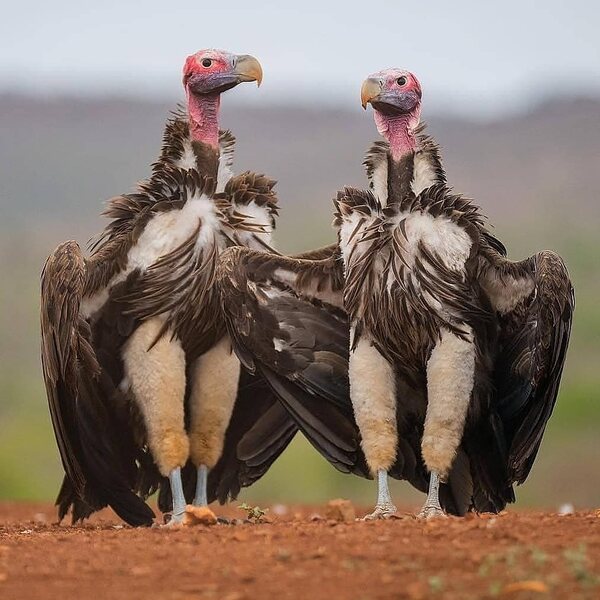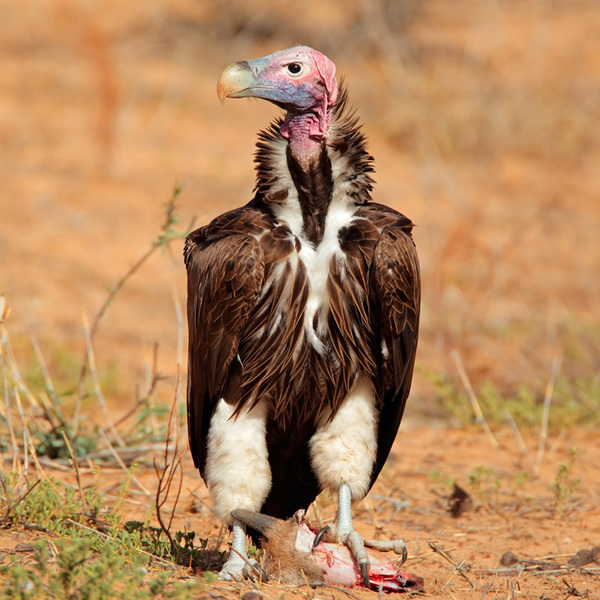The Lappet-faced vulture (scientific name: Torgos tracheliotos) is one of the most imposing vultures found in Africa. Known for its distinctive appearance and formidable presence in the wild, it plays a crucial role as a scavenger in the ecosystem. This article will explore the Lappet-faced vulture’s classification, physical characteristics, habitat, diet, behavior, conservation status, and more. Let’s delve into the life and significance of this extraordinary bird.

The Lappet-faced vulture belongs to the family Accipitridae, a family that includes eagles, hawks, and other vultures. It is the sole species of the genus Torgos, which distinguishes it from other vultures. The scientific name Torgos tracheliotos was given by Linnaeus in 1766, and it has been recognized as a unique species of vulture for centuries.
Kingdom: Animalia
Phylum: Chordata
Class: Aves
Order: Accipitriformes
Family: Accipitridae
Genus: Torgos
Species: T. tracheliotos
The Lappet-faced vulture is sometimes referred to by various common names, including:
Lappet-faced vulture
Arabian vulture
Egyptian vulture (though this can also refer to a different species, Neophron percnopterus)
Cape vulture (in South Africa)
Lappet-faced vultures are easily identifiable due to their striking appearance. Unlike some other vultures that have relatively smooth, bald heads, the Lappet-faced vulture’s face is adorned with distinct skin folds or "lappets". These fleshy folds of skin hang down from the sides of the bird’s beak, giving it its unique name.
Size: The Lappet-faced vulture is a large bird, standing at approximately 100-115 cm (39-45 inches) tall.
Wingspan: With a wingspan ranging from 2.3 to 2.6 meters (7.5 to 8.5 feet), the Lappet-faced vulture is one of the largest vultures.
Weight: They typically weigh between 6 and 9 kilograms (13 to 20 pounds).
Coloration: The plumage is mostly dark brown or black, with some areas of lighter feathers around the neck and head. The face itself is generally a light pink to reddish color.
Beak: The Lappet-faced vulture has a strong, hooked beak designed for tearing through meat, especially in large carcasses.
Eyes: The eyes are large and have a distinctive dark ring around them.
The physical features of the Lappet-faced vulture are specially adapted for its scavenging lifestyle. The bare head and neck allow it to feed on carcasses without getting messy, and the strong beak is perfect for tearing through tough hide and muscle. The broad wings and powerful flight capabilities allow the Lappet-faced vulture to cover large areas in search of food.
The Lappet-faced vulture is found primarily in Africa, although its range does extend into parts of the Arabian Peninsula. It is commonly seen in open savannas, grasslands, and semi-desert regions.
Africa: The Lappet-faced vulture is widespread across sub-Saharan Africa, particularly in countries like South Africa, Kenya, Uganda, Tanzania, and Ethiopia.
Arabian Peninsula: In addition to Africa, small populations of Lappet-faced vultures can be found in parts of the Middle East, particularly in countries like Saudi Arabia and Oman.
The Lappet-faced vulture is primarily a resident species, although some populations in more arid regions might undertake seasonal migrations in search of food.
Lappet-faced vultures thrive in open landscapes with ample space to soar and search for carcasses. They are commonly found in:
Savannas and grasslands
Semi-desert areas
Scrublands
Mountainous regions (particularly during the breeding season)
They require large, open spaces with minimal tree cover, as they need to soar high in the sky to spot food from a distance.
Lappet-faced vultures are generally solitary birds, especially when feeding on carcasses. However, they do sometimes congregate in groups at particularly rich food sources. These vultures are territorial during the breeding season and may defend their nests aggressively from other vultures and predators.
Despite their solitary nature, they often associate with other large scavengers, such as marabou storks and white-backed vultures, when feeding on large carcasses. However, the Lappet-faced vulture is known for being dominant in such feeding frenzies and can outcompete other scavengers for prime feeding spots.
The Lappet-faced vulture is an excellent flyer. Like other vultures, it uses thermal updrafts to stay aloft with minimal energy expenditure. With its large wingspan, the Lappet-faced vulture is capable of soaring over vast expanses of land while searching for food. It is also known to glide gracefully through the air, using its keen eyesight to spot potential carcasses from great heights.

As a carrion feeder, the Lappet-faced vulture feeds almost exclusively on the remains of dead animals. It is particularly skilled at feeding on the large carcasses of herbivores such as antelope, zebras, and buffaloes. The vulture uses its powerful beak to tear open tough hides and muscles, allowing it to consume a wide variety of animal tissues, including skin, muscle, and bones.
They play a vital role in the ecosystem by cleaning up carcasses and preventing the spread of diseases that could arise from decaying bodies.
Lappet-faced vultures have a relatively low reproductive rate, which is a common trait among many vulture species. They generally lay one egg per breeding season, and both the male and female share the responsibility of incubating the egg. The incubation period lasts about 55 to 60 days, and the chick hatches blind and helpless.
The parents continue to care for the chick after it hatches, feeding it regurgitated food. The chick fledge, or becomes independent, at around 4-5 months of age, although it may remain in the vicinity of the nest for several months afterward.
Lappet-faced vultures are long-lived birds, with some individuals reaching ages of 30 years or more in the wild. Their longevity is partly due to their efficient scavenging lifestyle, which minimizes their exposure to predators and hunting threats. In captivity, they can live even longer, with some individuals reaching over 40 years.
The Lappet-faced vulture is listed as Near Threatened (NT) on the International Union for Conservation of Nature (IUCN) Red List. Although it is not yet classified as endangered, the species faces numerous threats that have led to a decline in its population across Africa and the Arabian Peninsula.
Habitat Loss: As human activities expand into natural habitats, the Lappet-faced vulture's range has shrunk.
Poisoning: One of the biggest threats to vultures globally is poisoning, often as a result of farmers using toxic substances to kill predators or through poisoned carcasses left for lions or other carnivores.
Poaching and Illegal Hunting: The Lappet-faced vulture has been targeted by poachers for its feathers, which are sometimes used in traditional medicine or in rituals.
Decline in Food Availability: The decline of large herbivores in some regions due to poaching and habitat loss has made food scarcer for vultures. As apex scavengers, vultures depend on the remains of large animals to survive.
Efforts to conserve the Lappet-faced vulture are ongoing. These efforts include:
Protection of habitats through national parks and wildlife reserves.
Anti-poaching laws to protect vultures from illegal hunting.
Awareness campaigns to educate local populations about the ecological importance of vultures.
Collaboration with farmers to reduce the use of toxic chemicals and poisoning practices.
Here’s a table summarizing the different subspecies of the Lappet-faced Vulture (Torgos tracheliotos), along with their geographic distribution and key characteristics:
| Subspecies | Scientific Name | Geographic Distribution | Key Characteristics |
|---|---|---|---|
| Nominate Subspecies | Torgos tracheliotos tracheliotos | Sub-Saharan Africa (from West to East Africa) | Typical Lappet-faced Vulture appearance, found across a broad range. |
| Arabian Subspecies | Torgos tracheliotos neglectus | Middle East (Arabian Peninsula: Saudi Arabia, Oman) | Smaller population compared to the African subspecies, adapted to desert environments. |
Torgos tracheliotos tracheliotos: This is the most common subspecies found throughout sub-Saharan Africa, where it plays a crucial ecological role in open savannas and grasslands.
Torgos tracheliotos neglectus: The Arabian subspecies is more isolated and rarer, with the vulture occupying arid environments in the Middle East. This subspecies is less studied and has fewer documented individuals compared to the African populations.
Both subspecies share similar physical traits, such as the characteristic "lappets" on the face and a large wingspan, but the Arabian subspecies may have slightly different behavioral adaptations suited to the harsher desert environments.
Lappet-faced vultures are one of the largest vulture species, with a wingspan that can reach up to 2.6 meters (8.5 feet). This wide wingspan helps them soar gracefully for long distances in search of food, often flying high over vast landscapes.
The Lappet-faced vulture is easily recognized by its large, bald head and its characteristic "lappets", which are folds of skin that hang from the sides of its face. These lappets are often a bright pink or red in color and add to the vulture’s unique, almost regal appearance.
As a scavenger, the Lappet-faced vulture plays an essential role in its ecosystem by cleaning up carcasses. Their powerful beaks and strong digestive systems allow them to consume animal remains that are too tough for other scavengers.
The Lappet-faced vulture is an obligate scavenger, feeding primarily on the remains of large mammals, such as antelopes, zebras, and even Elephants-Are-Endangered.html">elephants. Unlike some other vultures, they are known to be aggressive feeders, often dominating other scavengers at a carcass.
Lappet-faced vultures are known for their dominance at feeding sites. They often chase away smaller vultures and other scavengers from a carcass due to their strength and size. However, they can also be seen feeding in groups, especially when the carcass is large enough to support multiple vultures.
Their beak is one of the most powerful among vultures, designed for tearing tough flesh and breaking bones. The beak's robust structure enables them to access difficult-to-reach food sources, such as the marrow inside large bones.
The Lappet-faced vulture is known for its exceptional soaring ability. With a wingspan of up to 2.6 meters, it can ride thermal air currents for hours, covering vast distances to find food. It often travels in search of carcasses, soaring high above the ground before spotting potential food sources.
Lappet-faced vultures have a slow reproductive rate. They typically lay one egg per breeding season, and both parents take turns incubating the egg. The chick hatches after about 50-55 days. These vultures can live for over 20 years in the wild, although many face threats that reduce their life expectancy.
Lappet-faced vultures are keystone species in their ecosystems. By scavenging carcasses, they help prevent the spread of diseases that could be transmitted from decaying bodies. Without vultures, carcasses would take much longer to decompose, posing risks to both animals and humans.
The Lappet-faced vulture is considered vulnerable by the International Union for Conservation of Nature (IUCN). Their populations are in decline due to habitat loss, poisoning from livestock carcasses, and illegal hunting. Conservation efforts are underway to protect this magnificent bird and its critical ecological role.
The Lappet-faced vulture is an essential species in Africa's ecosystems, playing a vital role in cleaning up carcasses and preventing the spread of disease. With its distinctive appearance, impressive flying abilities, and unique feeding habits, it is a fascinating bird. However, the species faces multiple threats, including habitat loss, poisoning, and food scarcity, making its conservation efforts crucial to ensure that future generations can continue to witness this magnificent bird in the wild.
animal tags: lappet-faced-vulture
We created this article in conjunction with AI technology, then made sure it was fact-checked and edited by a Animals Top editor.